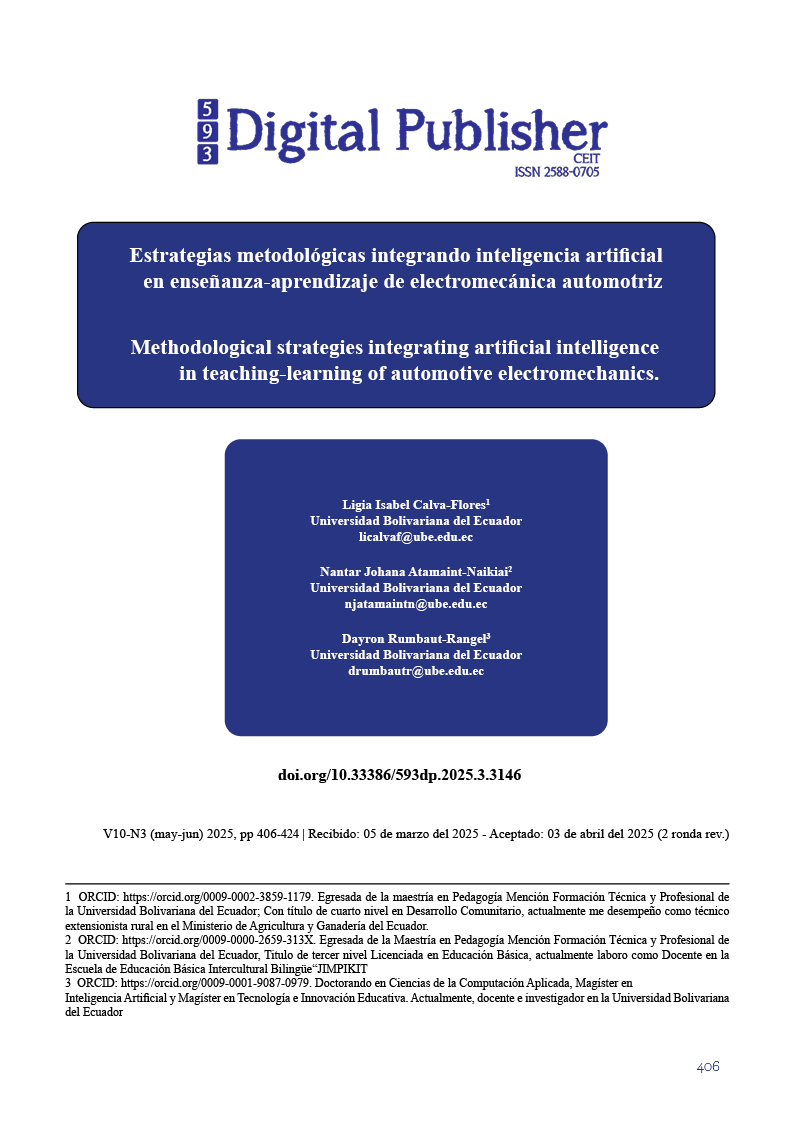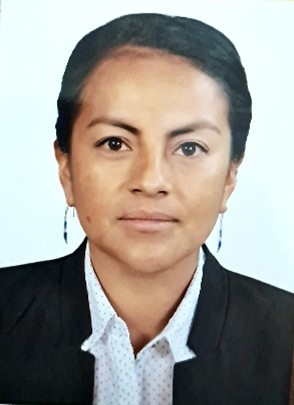Methodological strategies integrating artificial intelligence in teaching-learning of automotive electromechanics.
Main Article Content
Abstract
The present scientific article entitled " methodological strategies integrating artificial intelligence in teaching-learning of automotive electromechanics", focuses on the development of methodological strategies for the teaching-learning process based on the application of artificial intelligence (AI), where its primary objective is to develop and strengthen the professional skills of the students of the Second year of High School of the Automotive Electromechanical specialty at the Gualaquiza High School, through the application of tools based on AI to enhance their academic performance, where a methodology with a mixed approach was applied, based on an exploratory research design and its constructivist paradigm, where the results obtained met the parameters and planned research objectives, seeking to solve the problem in traditional education where technological tools such as the use of AI have not yet been applied, but the old methodology is being left behind and is gradually replaced with technological tools to interact with these media, in the results obtained, it was observed that AI has sufficient capacity to change the teaching and learning process and to improve the quality of education. The proposal is raised, which arises from the need to implement methodological strategies for the teaching-learning process based on the application of artificial intelligence. In conclusion, the implementation of AI-based assessments provides a powerful tool to examine and evaluate student performance objectively and effectively.
Downloads
Article Details

This work is licensed under a Creative Commons Attribution-NonCommercial-ShareAlike 4.0 International License.
1. Derechos de autor
Las obras que se publican en 593 Digital Publisher CEIT están sujetas a los siguientes términos:
1.1. 593 Digital Publisher CEIT, conserva los derechos patrimoniales (copyright) de las obras publicadas, favorece y permite la reutilización de las mismas bajo la licencia Licencia Creative Commons 4.0 de Reconocimiento-NoComercial-CompartirIgual 4.0, por lo cual se pueden copiar, usar, difundir, transmitir y exponer públicamente, siempre que:
1.1.a. Se cite la autoría y fuente original de su publicación (revista, editorial, URL).
1.1.b. No se usen para fines comerciales u onerosos.
1.1.c. Se mencione la existencia y especificaciones de esta licencia de uso.
References
Ayuso & Gutiérrez. (2022). La inteligencia artificial como recurso educativo durante la formación inicial del profesorado. RIED-Revista Iberoamericana de Educación a Distancia, 25(2), 362. https://doi.org/https://revistas.uned.es/index.php/ried/article/view/32332
Barakina, E. Y. (2021, p. 165). Digital Technologies and Artificial Intelligence Technologies in Education. European Journal of Contemporary Education, 10(2), 362. https://doi.org/https://ejce.cherkasgu.press/journals_n/1625228822.pdf
Bonilla, D. (2024). Chat GPT como Recurso para el Aprendizaje del Pensamiento Crítico en Estudiantes. Cienciamatria. Revista Interdisciplinaria de Humanidades, Educación, Ciencia y Tecnología, 9(17), 25. https://doi.org/https://ve.scielo.org/scielo.php?script=sci_arttext&pid=S2542-30292023000200036
Cai, D. (2020, p. 58). Aplicación del sistema de planificación inteligente en la construcción de un sitio web de enseñanza de inteligencia artificial. Guía de software, 13(1), 113.
ClassFlow. (s.f.). Title of the specific page or section. Blog, 12(1), 4.
Coello, J. (2024). El uso de Flipgrid para mejorar la producción oral y la pronunciación en el aprendizaje de inglés. Caso de estudio. Revista InveCom, 4(2), 14. https://doi.org/https://ve.scielo.org/scielo.php?script=sci_arttext&pid=S2739-00632024000200104
Díaz, F. P. (2023). Entorno virtual de aprendizaje para mejorar el nivel de comprensión oral b1 a través de la secuencia didáctica en los estudiantes de francés intermedio I de la Universidad de Pamplona. Colombia (Doctoral dissertation, Universidad de Cartagena)., 1(1), 234.
Galeas, I. M. (2024). Transformation and Challenges Of Higher Education in the Digital Age: Strategies for skill development in the 21st century.YUYAY: . strategias, Metodologías & Didácticas Educativas, 3(1), 33.
Gómez & Tituaña. (2023). Gamificación y gestión de la innovación digital: Caso de estudio de la educación superior(Bachelor’s thesis,. Repositorio de Universidad, 1(1), 321.
Hernández, L. (2019, p. 5). Tipos de investiagciones para el proceso cientifico. Revista educativa para el desarrollo de proyectos, 3(2), 56.
Hernandez, S. (2019, p. 7). Metodología de la investigación científica. Revista Metodológica de investigación, 2(1), 23.
LLC., A. d. (2024). Asistente de Google: tu asistente con inteligencia artificial . Google, 1(1), 5. https://doi.org/https://assistant.google.com/
López & Martinez. (2023). ERSONALIZACIÓN DEL APRENDIZAJE CON INTELIGENCIA ARTIFICIAL EN LA EDUCACIÓN SUPERIOR. Revista Digital De Tecnologías Informáticas Y Sistemas, 7(1), 54. https://doi.org/https://doi.org/10.61530/redtis.vol7.n1.2023.165.123-128
Navarro, e. (2023, p. 12). El futuro de la Inteligencia Artificial para la educación en las instituciones de Educación Superior. Siielo.sld.cu, 19(23), 54. https://doi.org/http://scielo.sld.cu/scielo.php?pid=S1990-86442023000400027&script=sci_arttext&tlng=pt
Prince, T. A. (2024). La inteligencia artificial como mecanismo para el aseguramiento del derecho a la educación. RECIE. Revista Caribeña De Investigación Educativa, 8(1), 20. https://doi.org/https://revistas.isfodosu.edu.do/index.php/recie/article/view/626
ProFuturo & OEI. (2023). El futuro de la Inteligencia Artificial en educación en América Latina. Revista Educativa, 23(12), 18. https://doi.org/www.profuturo.education
Rodríguez, V. (2024). La herramienta google classroom como apoyo al aprendizaje. Revista Arbitrada Interdisciplinaria Koinonía, 24(2), 15. https://doi.org/https://ve.scielo.org/scielo.php?script=sci_arttext&pid=S2542-30882023000400965
Rubistar. (s.f.). Rubistar: Create rubrics for your project-based learning activities. . Rubistar., 12(2), 5. https://doi.org/https://rubistar.4teachers.org/
Salmeron, Y. (2023, p. 13). The future of Artificial Intelligence for Education. Revista Científica Educativa, 19(93), 45. https://doi.org/http://scielo.sld.cu/scielo.php?pid=S1990-86442023000400027&script=sci_arttext&tlng=pt
Tello, Y. (2023). Herramientas digitales en la evaluación formativa durante el contexto pandémico. Horizontes Revista de Investigación en Ciencias de la Educación, 7(27), 23. https://doi.org/http://www.scielo.org.bo/scielo.php?script=sci_arttext&pid=S2616-79642023000100444
Troncoso, M. (2023, p. 32). Inteligencia artificial y educación: nuevas relaciones en un mundo interconectado. Revista Estudios del Desarrollo Social: Cuba y América Latina, 11(2), 58. https://doi.org/http://scielo.sld.cu/scielo.php?script=sci_arttext&pid=S2308-01322023000200014
Turnitin. (n.d.). What is Turnitin?. Blog, 12(1), Retrieved. https://doi.org/https://www.turnitin.com/
UNESCO. (2023, p. 5). Aprender a vivir en la era de la IA. Artículo Informativo, 1(1), 15.
UNESCO. (2021, p. 4). Aplicación de estrategias tecnológicas o inteligencias artificiales en el marco educativo. Revista Técnica de Información, 1(1), 12.
Vázquez, P. (2021, p. 9). La UNESCO y la gobernanza de la inteligencia artificial en un mundo globalizado. La necesidad de una nueva arquitectura legal. Vera, F. (2023). Integración de la Inteligencia Artificial en la Educación superior: Desafíos y oportunidades.Transformar,4(1), 17. Revista Educativa Scielo, 21(3), 34.
Zapata, L. (2021). Kahoot! mejora significativamente los resultados de aprendizaje de los estudiantes. Recursos digitales del sigo XXI, 23(2), 10. https://doi.org/https://kahoot.com/news/kahoot-mejora-significativamente-los-resultados-de-aprendizaje-de-los-estudiantes/
Zhun, Y. C. (2023). La Guía A-Z de la IA en la Educación 2023: Casi todo lo que necesita saber. Revista Científica Informática Educativa, 23(5), 15. https://doi.org/https://www.classpoint.io/blog/es/la-guia-a-z-de-la-ia-en-la-educacion-2023-casi-todo-lo-que-necesita-saber




